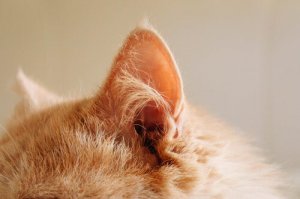5 Useful Tips When Taking Care of a Deaf Cat


Written and verified by biochemistry Luz Eduviges Thomas-Romero
Taking care of a deaf cat can seem like a difficult task. In addition to their usual needs, you’ll have to learn new ways to communicate anything you need to them in an effective manner!
As difficult as it may seem, in reality, this isn’t the case. Cats and humans are very adaptable beings, and, with some consistency, they can get to understand each other without any issues. In this article, we’ll give you five useful tips on how to take care of a deaf cat properly.
Deaf cats
Some cats are born deaf and others become deaf in the course of their lives. The most common cause of non-congenital deafness in cats is age. Other causes are related to different ear canal conditions such as otitis.
There is evidence of a correlation between a domestic cat’s coat pigmentation and the incidence of congenital hearing disorders. As a result, not all white cats are deaf, but white cats with blue eyes are more likely to be congenitally deaf, for instance.

Common signs of deafness in cats
To find out if your cat is or is becoming deaf, you’ll need to take them to the vet and pay attention to their behavior. A common symptom of deafness in cats is increased sleep time. This can be confusing as cats do like to sleep a lot.
A deaf cat may also seem to be more attentive. If you notice in your cat an unusual interest in you or other pets in the house, they may be trying to watch your movements more carefully.
Many deaf cats look attentively at you or other animals to know what’s happening around them. In addition, other common signs may include:
- Your cat doesn’t notice when you come back home
- They don’t respond to everyday sounds like their name, loud noises and squeaky toys
- They don’t wake up to loud noises anymore, like the doorbell
- May have increased sensitivity to odors and temperature.
These are some of the possible signs of deafness in cats. Remember to always ask your vet when in doubt.
Tips for taking care of a deaf cat
Despite their condition, deaf cats can be excellent pets. In a general way, their care is similar to that of a normal cat. Only certain details need to be taken into account that will make their life easier and make living together a more enjoyable experience for everyone.
1. Avoid frightening them
Cats that live in the house still possess their natural instincts. These instincts make them believe they’re always being hunted. As a result, sneaking on your cat can cause a lot of stress in them, even if it’s by accident.
Thus, it’s a good idea to use some visual cues to let your cat know when you’re approaching them. For instance, if they’re taking a nap and you’d like to get their attention, make sure you provoke some vibrations. Walk with a stomp or give a couple of loud pats. The shaking will alert them to your presence.

2. Train your deaf cat
Although they may be slightly different from other cats, it’s equally important to train them. As they’re more attuned to visual stimuli, take advantage of this to use your body as a form of communication.
When they look at you, get down on the ground and reach out your hand to call them. Reinforce their instinct to approach you by using a small treat.
You can also stand up and wave your arms above your head as you approach to communicate your disgust when they jump on to the kitchen counter.
In addition, you can teach a deaf cat not to jump on a table by using a squirt bottle filled with water to wet them a little. A squirt of water is not painful and will attract the cat’s attention if it’s looking away. Also, according to some experts, it can help correct the behavior without the cat becoming afraid of you.
3. Keeping your deaf cat safe
As you can imagine, there are many outdoor threats for a deaf cat. They can’t hear barking dogs, car horns, or people screaming.
Another useful option can be to teach your cat to walk on a leash. They’ll have a lot of fun walking around the neighborhood while staying safe. They can learn faster than you think!

4. Get them some company
All cats can benefit from having other pets around them, particularly other cats. This is especially true for deaf cats. Under these conditions in general, cats will take clues from other animals’ behavior to know what is going on.
Ideally, you should have two cats from a young age to make it easier for them to live together when they’re both older. If you have a deaf cat and would like to bring a new one to keep them company, it’s important to make sure their characters are compatible.
In addition, you should understand that both of them will go through an adjustment period. This can take anywhere from a few days to a few months. If you’ve made the right choice and given them adequate amounts of exercise, both cats will be happy to have a new friend.
5. Establish a routine
Cats are picky creatures who love routine and reliability. This is even truer when your cat is missing one of their senses. To avoid disorientation and stress, keep up with a reliable meal routine and avoid rearranging furniture.
By creating a schedule and sticking to it, you can quickly teach a deaf cat important household routines. Your cat can learn when meals happen and where to feed.
Cats, deaf or not, are still happy pets. In general, making simple adaptations for a hearing-impaired pet is not that difficult.
By opening your home to a hearing-impaired, four-legged friend you will discover an inseparable family member. You’ll both learn new ways to communicate!
We hope you found today’s article useful and that you’ll enjoy your cat’s company as much as they enjoy yours!
Taking care of a deaf cat can seem like a difficult task. In addition to their usual needs, you’ll have to learn new ways to communicate anything you need to them in an effective manner!
As difficult as it may seem, in reality, this isn’t the case. Cats and humans are very adaptable beings, and, with some consistency, they can get to understand each other without any issues. In this article, we’ll give you five useful tips on how to take care of a deaf cat properly.
Deaf cats
Some cats are born deaf and others become deaf in the course of their lives. The most common cause of non-congenital deafness in cats is age. Other causes are related to different ear canal conditions such as otitis.
There is evidence of a correlation between a domestic cat’s coat pigmentation and the incidence of congenital hearing disorders. As a result, not all white cats are deaf, but white cats with blue eyes are more likely to be congenitally deaf, for instance.

Common signs of deafness in cats
To find out if your cat is or is becoming deaf, you’ll need to take them to the vet and pay attention to their behavior. A common symptom of deafness in cats is increased sleep time. This can be confusing as cats do like to sleep a lot.
A deaf cat may also seem to be more attentive. If you notice in your cat an unusual interest in you or other pets in the house, they may be trying to watch your movements more carefully.
Many deaf cats look attentively at you or other animals to know what’s happening around them. In addition, other common signs may include:
- Your cat doesn’t notice when you come back home
- They don’t respond to everyday sounds like their name, loud noises and squeaky toys
- They don’t wake up to loud noises anymore, like the doorbell
- May have increased sensitivity to odors and temperature.
These are some of the possible signs of deafness in cats. Remember to always ask your vet when in doubt.
Tips for taking care of a deaf cat
Despite their condition, deaf cats can be excellent pets. In a general way, their care is similar to that of a normal cat. Only certain details need to be taken into account that will make their life easier and make living together a more enjoyable experience for everyone.
1. Avoid frightening them
Cats that live in the house still possess their natural instincts. These instincts make them believe they’re always being hunted. As a result, sneaking on your cat can cause a lot of stress in them, even if it’s by accident.
Thus, it’s a good idea to use some visual cues to let your cat know when you’re approaching them. For instance, if they’re taking a nap and you’d like to get their attention, make sure you provoke some vibrations. Walk with a stomp or give a couple of loud pats. The shaking will alert them to your presence.

2. Train your deaf cat
Although they may be slightly different from other cats, it’s equally important to train them. As they’re more attuned to visual stimuli, take advantage of this to use your body as a form of communication.
When they look at you, get down on the ground and reach out your hand to call them. Reinforce their instinct to approach you by using a small treat.
You can also stand up and wave your arms above your head as you approach to communicate your disgust when they jump on to the kitchen counter.
In addition, you can teach a deaf cat not to jump on a table by using a squirt bottle filled with water to wet them a little. A squirt of water is not painful and will attract the cat’s attention if it’s looking away. Also, according to some experts, it can help correct the behavior without the cat becoming afraid of you.
3. Keeping your deaf cat safe
As you can imagine, there are many outdoor threats for a deaf cat. They can’t hear barking dogs, car horns, or people screaming.
Another useful option can be to teach your cat to walk on a leash. They’ll have a lot of fun walking around the neighborhood while staying safe. They can learn faster than you think!

4. Get them some company
All cats can benefit from having other pets around them, particularly other cats. This is especially true for deaf cats. Under these conditions in general, cats will take clues from other animals’ behavior to know what is going on.
Ideally, you should have two cats from a young age to make it easier for them to live together when they’re both older. If you have a deaf cat and would like to bring a new one to keep them company, it’s important to make sure their characters are compatible.
In addition, you should understand that both of them will go through an adjustment period. This can take anywhere from a few days to a few months. If you’ve made the right choice and given them adequate amounts of exercise, both cats will be happy to have a new friend.
5. Establish a routine
Cats are picky creatures who love routine and reliability. This is even truer when your cat is missing one of their senses. To avoid disorientation and stress, keep up with a reliable meal routine and avoid rearranging furniture.
By creating a schedule and sticking to it, you can quickly teach a deaf cat important household routines. Your cat can learn when meals happen and where to feed.
Cats, deaf or not, are still happy pets. In general, making simple adaptations for a hearing-impaired pet is not that difficult.
By opening your home to a hearing-impaired, four-legged friend you will discover an inseparable family member. You’ll both learn new ways to communicate!
We hope you found today’s article useful and that you’ll enjoy your cat’s company as much as they enjoy yours!
All cited sources were thoroughly reviewed by our team to ensure their quality, reliability, currency, and validity. The bibliography of this article was considered reliable and of academic or scientific accuracy.
- Cao, Z., Xu, Y., Tan, X., Suematsu, N., Robinson, A., & Richter, C.-P. (2018). Electrical and optical co-stimulation in the deaf white cat. In Optical Imaging, Therapeutics, and Advanced Technology in Head and Neck Surgery and Otolaryngology 2018 (Vol. 10469).
- Muniak, M. A., Connelly, C. J., Tirko, N. N., O’Neil, J. N., & Ryugo, D. K. (2013). Synaptic Organization and Plasticity in the Auditory System of the Deaf White Cat, 83–128.
- Hartmann, R., Klinke, R., & Heid, S. (1997). Functional Organization of the Auditory Cortex in the Congenitally Deaf White Cat, 561–575.
This text is provided for informational purposes only and does not replace consultation with a professional. If in doubt, consult your specialist.








